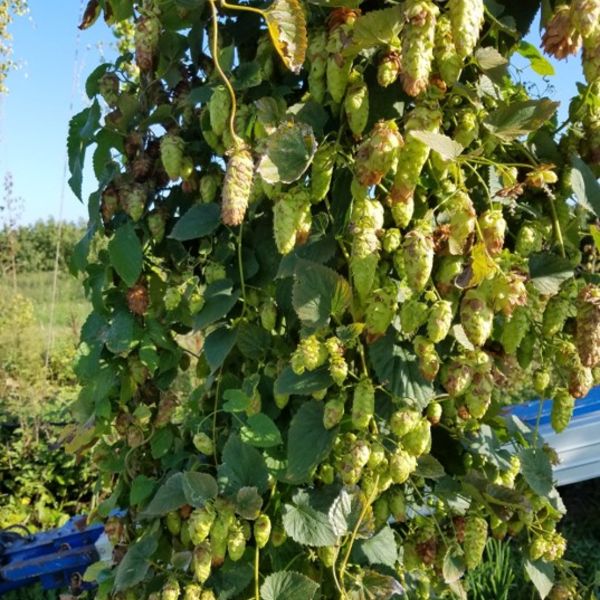Description
In 2017 we built a 1000-bine hops yard and a hops processing facility capable of harvesting and processing 125 bines per day.
Neighbors will recall that we put solar fence lights on top of the hundred poles that supported the bines, giving it the appearance that one neighbor described as “a runway for UFOs”.
The lights only lasted for one year. The hops lasted for two, but in 2019 they were all destroyed by downy mildew. We did what we had to do, which was to tear out the entire yard and start all over. We did that last fall and this spring.
We now have 125 Cascade, 125 Crystal, 125 Hallertauer, 125 Kirin, and 250 Mackinac and 250 Michigan Copper. All, but particularly the last two, did quite well this past summer – so well, in fact, that we may have limited supplies of them this coming fall.
Meanwhile, our hops processing facility remains fully operational. We have a Hopster® hops harvester, and now, if necessary, a trailer that can transport it to a location within 50 miles of our farm. We can process about one bine per minute, or 125 bines in two hours; setup and cleanup add 30 minutes at each end.
Our goal is to get the hops, ours or someone else’s, into our dryer, by 10:30 am or before the ambient temperature reaches 85 F, whichever comes first. 85 F is the point at which aroma starts to evaporate. Our dryer can reduce the water content of 125 freshly harvested hops from 80% to 20% in 8 hours.
Overnight, we spread the partially dried hops on to the floor of a 8 x 8 x 4’ four person Arctic Tent with two dehumidifiers. By the following morning, the water content of the crop is down to 8%.
At that point we run the dried hops through our Colorado Mill Equipment milling machine and then our Colorado Mill Equipment pelletizer.
The pelletizer has a liquid nitrogen feeder (seen through the mesh as the golden bronze fitting above the darker fenestrated sprayer) that bathes the pelletizer die to keep it, and the hops as they are being compressed, well below 85 F.
We put a specified number of pellets in each bag using a pharmaceutical pill counter. This assures that each bag has at least its declared weight.
We then seal each package with a vacuum bag sealer that has nitrogen purge capacity, and then store them in our freezer (on which these instruments sit) until purchase or use.
The customer we hope to find would be a home or a microbrewer, either of whom might be interested in blending our hops with other varieties. Because those customers, and for that matter the broader public, may not be familiar with all these hops, we have applied for a Small Brewery License. With this we will be able to sell six bottles of a single style (for example, IPA), each made with a different one of our six hops ,and all using our own Limagrain Violetta barley.
Meanwhile, if any local hops growers or dealers would be interested in our harvesting and/or processing capabilities, particularly for extra surge capacity at harvest time or for the smaller number of a specialty hop (for which our processing has been specifically scaled), we would be happy to hear from you.





